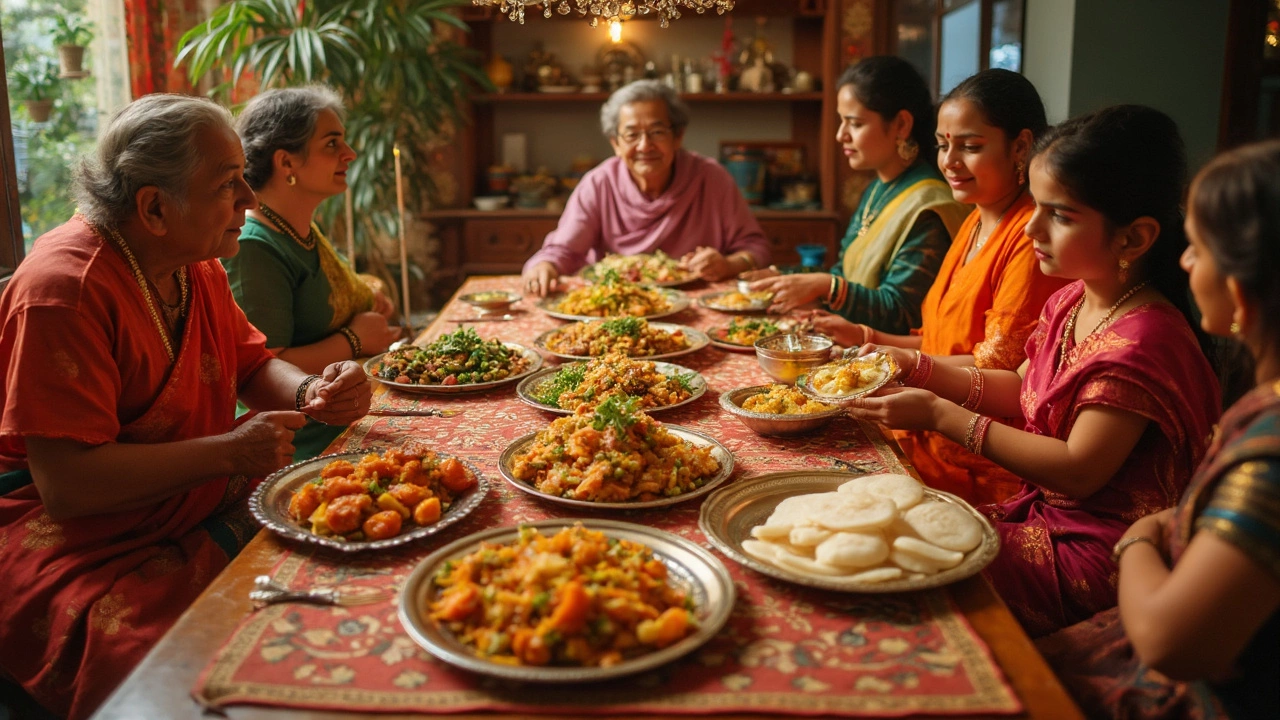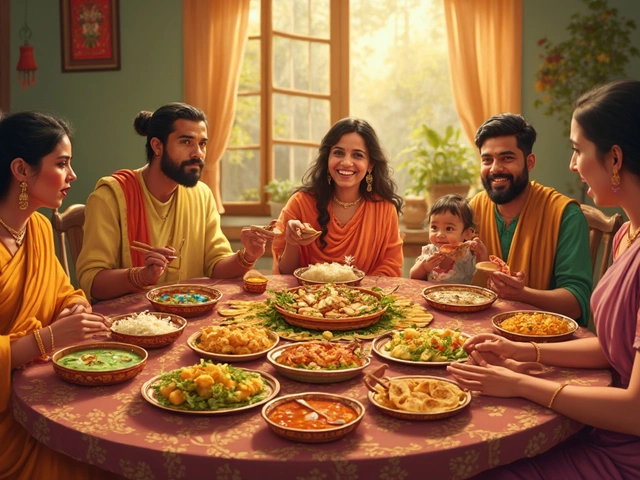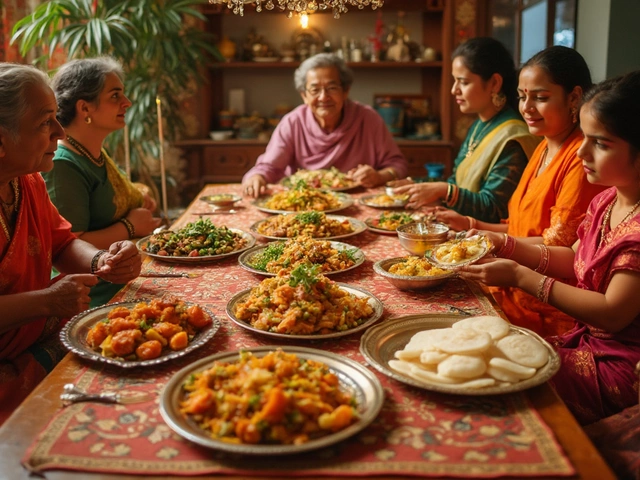There’s a lot of confusion about what Hindus eat, especially when it comes to meat like pork. If you grew up in or around Gujarati families, you probably noticed most meals are pure vegetarian. But is eating pork totally off-limits for all Hindus? The answer’s not as simple as yes or no.
Hinduism doesn’t have one universal law for food. Traditions vary from region to region, and Gujarat stands out for its strong vegetarian culture. In most Gujarati homes, especially those practicing Vaishnavism or Jainism, pork (and any meat) rarely appears on the table. This isn’t just about religion—it’s deeply tied to community values and what people see as clean or unclean food.
Still, things are shifting. Move outside traditional families, and you’ll find some Hindus, especially in cities or abroad, who do eat pork. It’s not common, but it’s happening more as food habits change with time and exposure to different cultures. If you’re planning a meal in Gujarat or inviting Hindu friends over, it’s just easiest to stick with vegetarian dishes. You’ll avoid awkward moments and show respect for everyone’s preferences.
- Religious Dietary Rules for Hindus
- Pork in Gujarati Culture and Daily Life
- Modern Attitudes and Changing Habits
- Practical Tips for Food Choices
Religious Dietary Rules for Hindus
If you’re curious about what Hindus can and can’t eat, here’s the scoop: there’s no single rulebook. Hinduism is super diverse, so food customs change depending on where you are, family traditions, and which beliefs people follow. Still, some patterns stand out—especially around meat and what’s considered “clean” food.
The big headline is that the cow holds a sacred spot in Hinduism. Eating beef is widely avoided, almost everywhere. But when it comes to pork, it’s not officially banned in the main Hindu scriptures. Instead, most dietary rules focus on keeping things pure and causing the least harm, which is why vegetarianism is so dominant, especially in Gujarat.
Different communities do things differently. Here’s a quick look at common dietary rules among Hindus:
- Many Hindus practice vegetarianism, avoiding all kinds of meat, including pork.
- Some Hindus eat meat, but usually steer clear of beef due to religious respect for cows.
- Pork isn’t mentioned much in classic Hindu texts, but some avoid it because of social or cleanliness reasons, not strict religious doctrine.
- Brahmins (the priestly community) are expected to be strictly vegetarian, while other groups might be more relaxed.
In Gujarat, vegetarianism is super popular, especially among Vaishnavas and Jains, two major groups there. Their rules are strict—they skip not just pork, but onion, garlic, and certain root veggies too. It’s about staying pure in both mind and body.
Want a quick glance at how meat-eating habits break down among Hindus across India? Check out this snapshot from a reliable 2021 Pew Research Center survey:
| Group | Vegetarian (%) | Eat Meat (%) |
|---|---|---|
| All Hindus (India) | 44 | 56 |
| Gujaratis | Around 70 | Around 30 |
| Brahmins (India) | ~76 | ~24 |
So bottom line: pork isn’t totally forbidden for Hindus, but for most in Gujarat, it’s just not on the menu because of strong vegetarian culture, not a strict religious rule. If you’re unsure about what’s okay, just ask or stick with vegetarian food—it’s the safest bet by far.
Pork in Gujarati Culture and Daily Life
When it comes to pork, Gujarati culture couldn’t be more straightforward: you’ll almost never see it at the dinner table. The strong vegetarian tradition in Gujarat is a big part of everyday life. Most households, restaurants, and even street stalls focus on vegetarian food. Samosa, dhokla, and thepla are stars here—not bacon or pork curry.
The roots of this go deep. Gujarat has a large population of Hindus (about 89% based on the 2011 Census), and many are from communities that avoid all types of meat, including pork. Groups like the Patels, Brahmins, and Jains tend to follow vegetarian diets as a mark of respect for living beings and for spiritual reasons. Even people who aren’t strictly religious often stick with these food rules because it’s seen as the norm in society.
If you walk into a typical Gujarati grocery store, your options for meat are extremely limited. In fact, here’s what you’ll usually notice if you compare food options in Gujarat:
| Food Type | Availability in Gujarati Stores |
|---|---|
| Vegetarian | Extensive (main focus) |
| Chicken/Mutton | Limited in select non-veg markets |
| Pork | Rare to none |
Pork products just aren’t a part of everyday Gujarati cooking. If you do come across pork, it’s usually in specialty stores or restaurants that cater to tourists or very specific groups. Even among non-vegetarian Gujaratis, pork isn’t the meat of choice; chicken or goat is far more common when someone wants to eat animal protein.
Thinking about festivals or weddings? Traditional Gujarati events almost always stick with an all-vegetarian menu. Serving meat, especially pork, can be controversial and sometimes cause offense, since it clashes with what most people expect and accept as food.
So if you're visiting Gujarat and wondering what to expect on local menus, count on a wide range of veggie dishes and maybe some chicken if you head to non-veg spots, but you’ll hardly ever see pork discussed or served. This comes down to the cultural and religious roots that have shaped eating habits for generations, making pork basically a no-go in daily Gujarati life. For anyone curious about Hindus and pork in this region, that’s the practical bottom line.

Modern Attitudes and Changing Habits
The way people eat in Gujarat isn’t frozen in time. With more folks moving to cities, traveling abroad, and connecting online, traditional food rules are getting tested. It’s not rare these days to find a young Gujarati who’s tried bacon or ham during a college trip or at a global restaurant in Mumbai or Ahmedabad. Still, for most families, especially in smaller towns or rural areas, sticking to a vegetarian diet is a mark of pride and respect for heritage.
Young people, especially those studying outside India or working overseas, tend to be more experimental. Some try pork out of curiosity or peer influence, but it rarely becomes a regular thing when they return home. There’s still plenty of social pressure—parents and grandparents usually expect old ways to follow at home, if not outside.
On social media, food bloggers who talk about non-veg eating habits in Gujarati communities sometimes get both praise and criticism. This shows just how mixed the opinions are. Even so, a 2023 Pew survey pointed out that about 21% of Hindus in India eat some kind of meat. For pork specifically, the number is even smaller among Gujaratis. Most people still avoid it, often for both religious and personal reasons.
It’s also practical: pork isn’t a common ingredient at local markets, and you’ll almost never see it on the menu in family-style Gujarati restaurants. If you do want to try it, you’d probably have to look for international supermarkets or specialty eateries in big cities.
This mix of curiosity, global influence, and old habits means there’s no single answer for everyone. If you’re unsure what to serve at a gathering, just ask. People appreciate honesty and openness about their food choices these days. Respecting the different attitudes goes a long way, whether you’re a local or a guest.
Practical Tips for Food Choices
Looking to navigate Hindu and Gujarati dietary habits without stepping on toes? Here’s what you really need to know. First, most Gujarati Hindus prefer a pure vegetarian diet. This means no pork, no chicken, and often, no eggs either. Milk, yogurt, and paneer are usually fine, but double-check if you’re not sure.
- If you’re hosting Hindu or Gujarati guests, always ask about their food preferences. It’s totally normal and shows you respect their choices.
- Restaurants in Gujarat—even fast food chains—usually have tons of vegetarian options. Some places serve only vegetarian food by default.
- When in doubt, stick to classic Gujarati dishes like dal, rice, rotli (roti), undhiyu, or khichdi. These are traditional, safe picks that work for almost everyone.
- Avoid serving pork at community or festival meals. It’s seen as unclean by many, so it’s best to leave it off the menu.
- Be careful with sauces and side dishes—sometimes meat or animal fat might sneak in, especially at non-vegetarian restaurants.
Here’s a quick table showing how common certain foods are in Gujarat:
| Food Item | Common in Gujarati Homes (%) |
|---|---|
| Vegetables/Legumes | 98% |
| Paneer/Dairy | 95% |
| Eggs | 30% |
| Poultry (Chicken) | 10% |
| Fish | 5% |
| Pork | <2% |
Also keep in mind: religious holidays matter. During Navratri, Shravan, or Ekadashi, many Hindus avoid not just meat, but onion and garlic too. If you want to be extra thoughtful, go for simple vegetarian food during these times.
One last thing—don’t stress if you’re not sure about the rules. Most people appreciate honesty. Just ask, listen, and you’ll probably get it right.






Write a comment